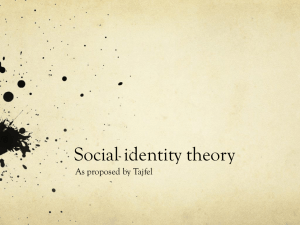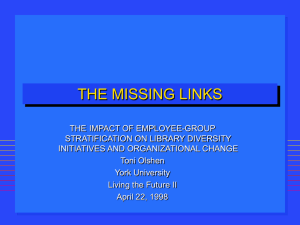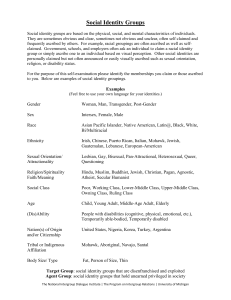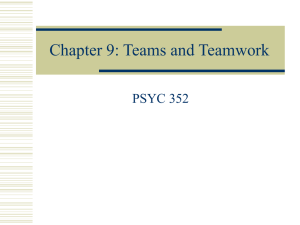social identity theory (sit)
advertisement
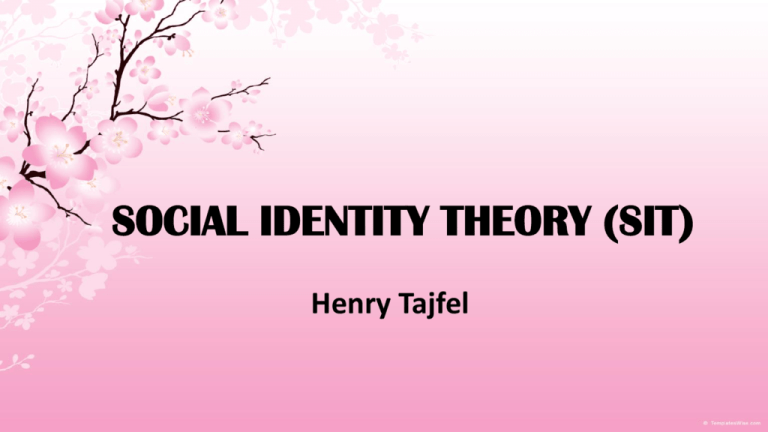
SOCIAL IDENTITY THEORY (SIT) Henry Tajfel SIT • Social identity is a theory expounded by Henri Tajfel and John Turner to understand the socialpsychological basis of intergroup discrimination and conflict. • Social Identity is seen as the process that changes interpersonal to inter-group behavior. • Social Identity is seen as the process that changes interpersonal to inter-group behavior. • "Emphasizes group process and intergroup relations." (Andreassi, Desrochers & Thompson) • "A social psychological theory of identity formulation that privileges the role of large group identities in forming individuals' concepts of self." (Calhoun, 2003). • Group in individual (Gogg & Abraham, 1988) SIT • The basic idea is that a social category (e.g., nationality, political affiliation, sports team) into which one falls, and to which one feels one belongs, provides a definition of who one is in terms of the defining characteristics of the category-a self-definition that is a part of the self-concept" (p. 259). (Desrochers) SIT • It stresses the psychological basis of group formation. • The need for self-esteem is seen as the basis for identification with groups and therefore person’s need to see the groups s/he belongs to as positively distinctive. • Social identity theory contrasts with some other theories of the process of group formation and intergroup conflict. SIT • It asserts that Individual identity is different from Social idenity so is individual self and social self. SIT SIT is composed of following elements: 1. 2. 3. 4. 5. Categorization Identification Comparison Psychological Distinctiveness Positive Self-esteem SIT CATEGORIZATION: people often put others (and ourselves) into categories. Labeling someone a Muslim, a Ethnic group, a Hindu or a Dalit are ways of saying other things about these people. SIT IDENTIFICATION: People also associate with certain groups (ingroup and out-group), which serves to bolster the self-esteem. Internalization of the group norms and values, accepting other members as ‘us’ is important SIT COMPARISON: People compare in-groups with other groups, seeing a favorable bias toward the in-group to which we belong. Each people belongs to several and identify with group that resembles with them most and compare with other group. SIT PSYCHOLOGICAL DISTINCTIVENESS: A desire to have an identity to be both distinct from and positively compared with other groups. Salient characteristics are accentuated that show distinctiveness and emotionally bind the group. Self Concept is a multi-dimentional construct that refers to an individual’s perception of “self” in relation to any number of characteristics such as academic/nonacademic, etc. Self-Image s the mental picture (resistant to change) that include physical as well as personal experiences. Self-Esteem: A concept of psychology that refers to someone's personal assessment of self worth. It reflects a person’s overall evaluation or appraisal of his or her own worth. Self-esteem encompasses beliefs (e.g., "I am competent" or "I am incompetent") and emotions such as triumph, despair, pride and shame. A person's self-esteem may be reflected in their behaviour, such as in assertiveness, shyness, confidence or caution. SIT PRINCIPLES 1. Group in individual (Gogg & Abraham, 1988) 2. Basic assumption begins with social group not with individual as in most of the psychological sciences 3. It has cognitive and behavioral component. Group behavior begins with solidarity within a group and discrimination with out-group. SIT PRINCIPLES 4. Maximizes out-group differences and minimize the in-group differences increases group favoritism which ultimately leads to selfenhancement. SIT PRINCIPLES • Social group is perceived as having three major components and evaluated accordingly 1. Cognitive component (knowing the group member) 2. Evaluation component (positive or negative evaluation of the group member) 3. Emotional component (positive or negative emotion associated with group member) SIT CENTRAL HYPOTHESIS 1. Seeks to find negative aspects of an out-group member to enhance the self-image 2. Seeks to find intergroup differences (tendency to see all out-group member possessing the same characteristics and guided by similar norms and values) 3. Seeks to find similarities in intra-group (tendency to see similarities within the group to generate ‘weness’ feeling) SIT CENTRAL HYPOTHESIS 4. Personal and social identity represent different levels of self categorization ie., individual difference and collective similarities • Individual define themselves in terms of their social group membership and try to seek a positive social identity • Social identity consist of those aspects of an individual's self image derived from social categories to which the person perceives himself to belong to & to value and emotional significance ascribed to membership • Thus they define themselves in terms of group membership • A positive social identity is achieved by comparing with others to establish a positively valued psychological distinctiveness. SIT : MOTIVATIONAL/COGNITIVE FACTORS • A need for intergroup differences is must • Positive comparison in favor of in-group is made that provide a satisfactory social identity • When negative comparison is made dissatisfaction occurs • SIT differs from earlier group theory on Two key respect… earlier notion… • Sumner's claim differs…ethnocentrism is rampant • Social group differentiate on dimension that provide favorable view…superior • Intergroup discrimination driven by in-group favoritism (not outgroup derogation /Brewer 1979) • Sherif's claim that goal causes conflict…not correct (wrong)…social categorization cause group discrimination. MINIMAL GROUP PARADIGM RESEARCH • • • Divided group on trivial criteria eg. Abstract painting Division of group was random Participants have to distribute rewards between pairs (not themselves) • It is minimal, because of the selection of group on minimal criteria…the reasons are – – – – – Categorization was based on trivial criteria No explicit conflict of interest No previous hostility Participants not engaged in face to face social interaction No rational link between economic self-interest and the strategy of favoring one's own group. Findings • Though made some effort to be fair but showed persistent tendency to give higher rewrds to another unknown ingroup • Participant keen to ensure that their fellow in-group member receive a higher reward than other G • Did not maximize the in-group or maximize joint gain • According to SIT, only way for participant to obtain a positive social identity by identifying with group into which they are categorized so they ensure their group comes off best in the only available comparison between the group (giving more rewared). IS IT MINIMAL? • They constitute maximal group (Tajfel (1978) • Small beginning can grow large conflict • It is difficult to overestimate the importance of social categorization and its link via social comparison to social identity and the need for psychological distinctiveness. • This SIT claim is supported by many other Lab studies • It has become the dominant explanatory framework for the study of intergroup relation OUTSIDE LABORATORY • In reality group in conflict often differ in status and changing status relations and perceived legitimacy are crucial determining characteristics in intergroup relations • When Minority group perceives dominant group's position as illegimate and unstable it may use strategies to obtain positive identity • May redefine characteristics of in-group previously seen as negative • May find new dimension for making comparison • May find a new group for comparison • When comparison are made directly on dimension as power and status…minority demands equality. • This may threaten the identity of the dominant group leading to backlash off minority. SIT HELPS TO UNDERSTAND THE BEHAVIOR OF THOSE WHOSE IDENTITY IS PERCEIVED TO BE THREATENED AND WHOSE BEHAVIOR MIGHT OTHERWISE SEEM QUITE IRRATIONAL AND POINTLESS. WHAT HAPPENS IF GROUP FAILS TO SATISFY… • Try to change the social structure (social change) • Seek a new way of comparison that favors the group and reinforce social identity (social creativity) • Leave/abandon the group to join the better on (social mobility) • Marching of ethnic group/women/protestant/ etc. has taken a character of ethnic/sex/religious consolation… • In SIT terms it can be understood feeling their identity is threatened and such opportunities must be taken to stand up to Majority community and show its identity is still important and valued. WHAT IS THE SPECIAL OF INTERGROUP BEHAVIOR? Interpersonal and intergroup behavior…differences • Interpersonal behavior is completely determined by interpersonal characteristics of those involved • Intergroup behavior concerned relationship that is defined totally in terms of person's membership is social group or categories (e.g., killing a out-group innocent, unknown member in conflict simply because he is the member of out-group) DISTINCT CRITERIA FOR INTERGROUP BEHAVIOR • At least 2 identifiable groups should be in the situation (Hutu/Tutsi, Catholic/Protestant/ Serb/Croat/ Hindu/Muslim) • Little variability of behavior and attitude in each group, • Behavior appears uniform (e.g., we agree about them) Interpersonal behavior shows individual differences • Member show little variability in his perception or treatment of out-group member (they are all alike). Tajfel: "treated as undifferentiated item in unified social category" GROUP BEHAVIOR IS QUALITATIVE DIFFERENT IN IN-GROUP SETTING • When group membership is salient (in conflict) person tend to be depersonalized. • This is not a loss of identity (de-individuation) but a shift from personal to social identity. • Concern of ingroup takes over from concern of self, ingroup favoritism replaces self-favoritism, self is stereotyped as an ingroup member, ingroup is viewed as coherent and homogenous • Group is more competitive and aggressive thqan individuals (schopler & Insko, 1992) Brewer (1997) suggested in/out group schema consisting 3 principles that likely to operate in any social situation in which a particular in/out group categorization is made salient: • Intergroup accentuation principle: assimilation within category boundaries and contrast between (with out) group. All in group are seen similar than... • In-group favoritism principle: selective genealiation of positive affect (trust/liking) to fellow in-group but not to outgroup • Social competition principle: intergroup social comparison is typically perceived in terms of competition rather than comparison. THEORETICAL IMPLICATION ON DISTINCTION BETWEEN INTERPERSONAL AND INTERGROUP BEHAVIOR: Theoretical implication • First, intergroup phenomenon is very unpredictive if explained from interpersonal relation • Second, Individual if depersonalized, group has its effect, intergroup behavior is influenced by intergroup relations of status, power etc. not by interpersonal relations. (e.g., Friend but Boss) • Third, some variables that may have effect on interpersonal relations may have a different effect on intergroup relations. E.g., similarity may have attractive properties at an interpersonal level but it may threaten group distinctiveness and may lead to intergroup discrimination (BROWN, 1984) Tajfel (1979): intergroup behavior requires a different level of analysis from intra-group or interpersonal behavior. TYPES OF CONFLICTS • Objective conflict • Subjective conflict OBJECTIVE & SUBJECTIVE CONFLICT • Conflict over power, wealth, or territory • Outside the realm of psy…require an analysis in terms of social, economic, political and historical structures. • Distinct from psychological, symbolic/subjective conflict, such as attempts to establish positively valued distinctiveness. • Distinct but both are interwoven & subjective conflict can exist long afer objective disparities disappear (Deutsch, 1973…destructive conflicts) EXPLICIT AND IMPLICIT CONFLICT EXPLICIT CONFLICT • Explicit conflict is legitimized and institutionalized by rules or norms (Sherif's study) • According to Tajfel & Turner (1979) behavior toward out-group can be classified into 2 categories: • Instrumental behavior: action aimed at causing the in-group to win the competition Non-instrumental behavior • Non-instrumental behavior: behavior is more interesting psychologically, because it is gratuitous (without cause) discrimination against out-groups and has no sense outside the context of intergroup relations…negative stereotypes to members of out-group & to a group as a whole. – Generally a set of traits is attribute to all members of category – Individuals belonging to this category are assumed to be similar to each other…different from in-group on particular traits. – Treting out-group in this way makes them more predictable, can be used to justify discriminatory behavior. – Helps members to differentiate the in-group positively from the out group. Implicit conflict • This conflict exist in the absence of explicit institutionalization) no conflict of interest yet it remains.Differentiations are made yet no reasons for these differentiations to occur (e.g., Hutu and Tutsi in Rwanda). • EXAMPLE Hutu & Tutsi are not ethnic or tribal groups…same language, religion, and culture, history of extensive intermarriage and even exchange identities. Essentially the same people. Difference were emphasized by colonialists leading to exaggeration of quite small differences in physical attributes such as height and skin color….social differenctiation concluded with a deliberate genocide…causes complex but include a psychological component (Tajfel experiment…no conflict of interest…simply categorization) Social psychological significance: • Most evident in the case of implicit conflict • When objective and subjective conflicts become inseparable…and where a contemporary subjective conflict has outlived a more ancient objective one. • Many pointless conflicts becomes more understandable when viewed as, at least in part, attempts to establish, maintain, or defend cherished social identities. Final words… IS IT POSSIBLE TO INCREASE SELF ESTEEM BY minorities? • Exhibit high level of self-hatred and they try to confront it: • Legitimate n stable social system has no visible alternatives to the status que…out-group (if minority) accept the inferiority • If (social system) seen as illegitimate soon alternative is searched (e.g., equality). System loses stability, oppression and terror begins • If majority-minority relations perceived as illegitimate…system no longer stable, rejection follows…redefine the group's characteristics and try to transform social identity into a positive one. • When minority reject their status, when there is unstable intergroup boundaries, they prefer assimilation. • Social wall penetrated or prevented. • If economic and political interests are there between group…interethnic violence and bloodshed erupts. One way • If the social system is perceived as legitimate and stable, and there are no visible alternatives to the status quo, or there is no conceivable prospect of any change in the nature of the system (such as in a feudal society ), they just accept their inferiority; they acquiesce (they agree or express agreement) . Second way • If the system is perceived as illegitimate by the minority, very soon alternatives begin to be envisioned. The system loses its stability, and oppression and terror by the majoritycontrolled state becomes the only way to maintain it (e.g., South Africa during the late apartheid era) (Hutnik, 1991). Third way • If the majority-minority relations are perceived as illegitimate and the system is no longer stable, the minority group members will tend towards a rejection of their inferior status. They then may reinterpret and redefine their group's characteristics and, thus, try to transform their social identity into a positive one. Social walls are created both by majorities and minorities One tries to penetrate, the other resists. This situation, combined with tangible differences of economic and political interests between the two groups, leads to minoritymajority conflict, which, if not managed at an early stage may result in interethnic violence and bloodshed.


